

 |
||
 |
||
Vol. 10 (1): June 2007 |
||
Algeria / Greece / Italy / Madeira / Malta / Mauritania & Western Sahara / Turkey
Turkey
|
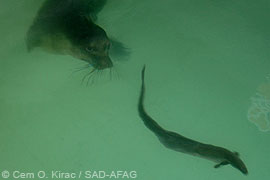 |
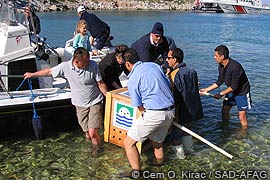 |
|
|
|
|
On the morning of the same day, as scheduled, a ceremony was held in Foça to commemorate this important and unique event. Mr. Osman Pepe, Minister of Environment and Forest, Mr. Cengiz Kaptanoğlu and Mr. Kemal Anadol, both Parliamentarians, the Izmir Governor, Foça Governor, Foça Mayor, President of the SPA Authority, Lenie ’t Hart (SRRC, the Netherlands), MOm (Greece), MAREVIVO (Italy), SAD-AFAG, Foça residents, and conservationists and guests from Ankara, Istanbul and Izmir, as well as the press and media, were present at the ceremony, which commenced at 9.45. Following presentations on Badem’s rehabilitation and the historical significance of Foça to the monk seal, and speeches delivered by various speakers, the Foça Monk Seal Rehabilitation Centre was visited by the participants; the seal pup was taken for transport to her release site at 10.50.
Following transport by SAD-AFAG van and a Coast Guard boat, Badem, named by both Esra and Aylin, daughters of Mr. Koç, was brought to the release site at about 16.45, and she was released at 17.26. Both the coast and the underwater vicinity were thoroughly examined by divers to ensure there were no sharp or foreign objects. The release coast and vicinity have no village settlement, no fish farms and no fishing community. The only way to reach the area is by sea.
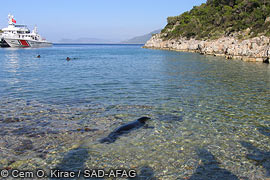 |
|
|
|
Badem left her wooden cage without hesitation after the gate was opened by Aylin Koç, the young daughter of Mustafa Koç, and she stayed on the shore only for about a minute before entering the sea. The pup then swam around the shoreline waters of the bay for approximately 1 hour and 20 minutes, moving calmly and diving, before leaving the area at 18.50. Badem was seen in and around the town of Datça on 6 May, and sometimes approached people, an occurrence sometimes observed in monk seals following rehabilitation. Badem is healthy and is able to forage by herself. SAD-AFAG continuously monitors Badem in and around Datça with its representative Sezer Çete and monk seal information network member Hasan Çiplak in Datça.
Both Hasan and Sezer worked day and night in order to observe the young seal’s movements as well as her interaction with locals and tourists.
Veterinarian Avni Gök of Foça Municipality and Richard Dijkema of the SRRC as well as SAD-AFAG staff also visited Datça twice for observation purposes.
The Governor and Mayor were contacted, and also visited several times, and agreed on certain coordinated actions. An action plan was prepared and implemented. Hasan, Sezer, Harun and Avni held a meeting with a slide presentation for local people, hotel owners, students, teachers, fishermen, environmentalists and local governor officers on the status of monk seals generally and on Badem’s case in particular. In accordance with the plan, stakeholders were cautioned not to interact with the young seal for the benefit of all concerned – locals, tourists and Badem.
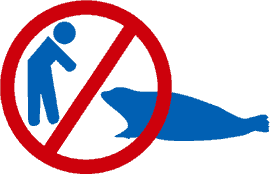 |
|
|
SAD-AFAG caution sign, part of an advisory flyer distributed to the public. |
A caution sign with concise information, designed by SAD-AFAG with Greek NGO MOm’s advice, was provided to the local governor and mayor who printed and distributed it at certain coastal locations. As of 24 May, the young seal was observed in Kormen port, and on 25 May near Knidos cape by local fishermen. On 30 May she appeared on Bördübet bay in Gökova. The distance she travelled is more than 70 nautical miles in a relatively short period of time. SAD-AFAG is now in continuous contact with a camping site and a hotel, the only two tourism facilities on the pristine Bördübet coasts, following the same procedure undertaken previously in Datça. The cooperative actions of the hotel and camping site owners will help solve this unwanted situation. The behaviour of tourists and local people are the key element: “no interest” by people will discourage Badem from staying in that area. This was demonstrated in Kormen, where Badem was seen on 24 May in the early morning and left the port at noon due to the cool behaviour of fishermen and other local people in the area, as counselled by us. SAD-AFAG provides the same advice to neighbouring settlements around the Datça Peninsula, delivering the message to tourists and locals that “every touch, every close interaction will slowly bring about Badem’s end” – expecting them to act far more responsibly.
SAD-AFAG greatly appreciates the partnership with Foca Municipality and assistance received from the Turkish Coast Guard, the Zeehondencreche Lenie ’t Hart (SRRC) and Mr. Mustafa Koç during the rehabilitation and release process. Details of this process were conveyed to the Ministry of Environment & Forest and Coast Guard Command, and shared transparently with the media and public via the SAD-AFAG web site www.sadafag.org and press interviews.
The return to the wild is a critical process for Badem, but people should help her in this difficult and last mission. And SAD-AFAG needs the support of all parties concerned to help Badem.
The Foça Municipality Mediterranean Monk Seal Rehabilitation Centre is now a good opportunity for ailing or orphaned monk seals that might possibly be encountered along Turkish coasts in the future. SAD-AFAG and the Foça Municipality are keen to work together on the rescue & rehab of this endangered marine mammal. – Cem Orkun Kiraç and Harun Güçlüsoy, SAD-AFAG.
Further info
Video of Badem and her rehabilitation can be found on youtube.com at:
http://www.youtube.com/watch?v=XMOSb3-tGgI
http://www.youtube.com/watch?v=MolDeS241jg
For the rehab diary of Badem (English and Turkish), visit http://www.sadafag.org.
Mordogan falls into one of the most important monk seal sites of Turkey declared by SAD-AFAG in 1998. The Ayibaligi zone, with its rocky cliffs, also includes an important breeding cave for the species.
However, as was determined during the 1990s, human pressure has been playing a negative role on monk seals in the area. People using the rocks to sunbathe and swim in summer have been a source of stress for the seals.
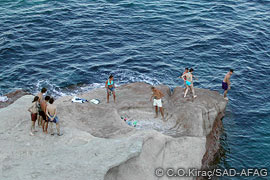 |
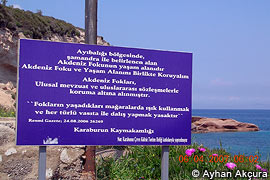 |
|
|
A picture of the past at the Ayibaligi rocky cliffs. |
Advising the public of the new rules. |
SAD-AFAG, together with Karaburun Local Agenda (KLA) 21, had proposed bringing in a regulation on the use of the adjacent sea and coastal area near the Ayibaligi cliffs and cave during 2001 and 2002. Finally, when it was introduced again to the agenda of Mordogan Municipality and Karaburun Local Governor early this year, the proposal was evaluated positively, and canoeing, swimming, diving and sailing have now been banned, though local people and tourists may still enjoy sea and sun just a few hundred meters south of the cliff area. Informative signs were designed jointly by SAD-AFAG and KLA 21 and erected at the site by the Municipality in April 2007. The sea border will be marked by buoys that will soon be installed by the Municipality, the Local Governor, KLA 21 and SAD-AFAG. With the help of this new regulation, we hope that breeding will continue by monk seals still frequenting the relatively protected rocky area. – Çigdem Akçura and Ayhan Akçura, KLA 21, and Cem Orkun Kiraç and Harun Güçlüsoy, SAD-AFAG.
According to volunteers and press reports, monk seal orphan “Badem”, who underwent rehabilitation in Foça under the supervision of the Zeehondencrèche Lenie ’t Hart (SRRC) of the Netherlands, has been interacting with humans on a regular basis since 6 May, following her release on 28 April. There are suggestions that the young seal may have become imprinted on her human carers during the 5-month rehabilitation process. Locals and tourists have been photographed playing and swimming with Badem, and there have been almost 20 reported instances of people being bitten by her.
Within days of her release in an unspoilt and unpopulated area on Gökova Bay, Badem appeared in the harbour of Datça town and began interacting with local people, though reportedly refusing the fish they tried to feed her.
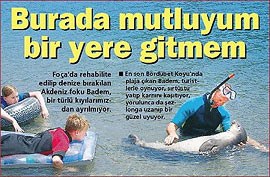 |
|
|
Badem hits the headlines in the mass circulation Turkish newspaper, Hürriyet, 1 June 2007. The caption reads: “I am happy here, I will not go anywhere... the released seal that was rehabilitated in Foça will not leave our coast... she plays with tourists, lets her belly be scratched and when tired she lies on a sunbed to rest..." |
Veterinarian Avni Gök of the Foça Municipality, nurse Richard Dijkema of the SRRC, and SAD-AFAG staff visited the area on several occasions, both to monitor the animal and to advise locals on the risks of interaction. However, despite an informal grouping of volunteers, there appears to be neither the manpower, budget nor official sanction to implement continuous monitoring and surveillance, 24/7.
There are now growing concerns that interactions may worsen during the summer tourist season, now looming. Some monk seal volunteers in Turkey believe that adequate precautions should be taken immediately to prevent harassment of the seal on the one hand, and potential injury to ill-informed tourists/bathers on the other.
National and local press reports vary between expressing editorial delight at the seal’s antics and concern for her welfare. On at least one occasion local papers have questioned the absence of veterinary care and protection as the seal appeared on a local beach, reportedly weak and shivering from exhaustion.
Most recently (30 May), Badem has been observed and photographed interacting with bathers at a beach club between Datça and mega holiday resort, Marmaris.
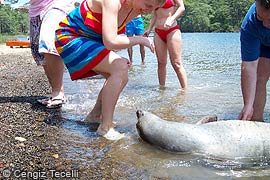 |
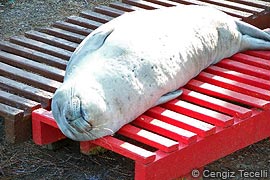 |
|
|
|
|
Conservation ecologist Gul Moran, who has been monitoring Badem’s post-release activity through information from a local NGO member in the area reports that:
“Badem was said to have been handled by her rear flippers during rehab, and thus, she bites everyone who touches her at this vulnerable point. So far, she bit nearly 20 people. The news was in all local and national news papers... She has become the main attraction along this coast.
The tourism season is just starting... in June schools will close and all the secondary house owners will move to the South. The area is going to be extremely crowded... ‘blue voyage’ sail boats, motor cruisers, package tour sailings, ‘banana’ boats, ‘parasailing’, catamaran-mobile-disco's, zodiacs, sports fisherman etc... all will be here.
There has been no extensive and continuous public awareness work yet, or monitoring, or any precautionary action from the Ministry of Environment. Nevertheless, Badem’s movement, after her appearance in Datça harbour, is followed, noted and reported by two local volunteers allocated by the national NGO SAD-AFAG.”
Those volunteers are SAD-AFAG’s Monk Seal Network members, Sezer Çete and Hasan Çiplak. “Sezer Çete and I have been following Badem since she appeared on the Datça coast,” says Çiplak. “We monitored the young monk seal very closely and informed the public and tourists not to approach or to interact with the seal, both for their own sake and the seal’s.”
Foça town veterinarian Avni Gök says: “I have visited Datça twice as part of the SAD-AFAG monitoring team after Badem reached here. According to my observation, the only problem arises from the people who showed great affection to this beautiful animal. We have explained to them in a tireless way not to interact with the seal and indeed to show no interest at all, so that the young and inexperienced seal will leave the area as a result. From a veterinary point of view, she is very agile, able to hunt by herself and very healthy in general. However, people should act much more responsibly and should consider the consequences of their close contacts with Badem.”
Information provided to TMG appears to imply that Badem returned to Gökova Bay of her own accord, rounding the entire Datça peninsula once more. Other reports, however, indicate that the animal was in fact recaptured at the port of Datça town and was then driven across the peninsula and re-released on Gökova Bay, eventually finding more human company at the aforementioned beach club.
Badem is not the first Mediterranean monk seal to become imprinted on its carers. The Greek organisation MOm faced a similar problem with the male orphan Theodoros in the 1990s on Alonissos, in the Northern Sporades Marine Park. His interactions with humans lasted about two years, after which (a period in which he increasingly shunned human contact), he disappeared. On the plus side, his interactions with humans probably made him the most effective goodwill ambassador for his species ever – though Alonissos, it should be stressed, is less busy touristically, and MOm personnel were on hand to educate and deal with potential interaction problems. [See The Islands at the End of the Line, TMG 4 (2): November 2001].
Two rehabilitated monk seals in Mauritania, we believe, also either became imprinted on their carers, or did not adapt well to their release into the wild. Both were subsequently killed, one by a fisherman or hunter [See Monk Seal Fact Files > Rescue and Rehabilitation].
In some instances wild monk seals (especially juveniles) may also interact with humans, as is seen regularly on the Main Hawaiian Islands and, closer to home, at Madeira. Madeira has published a ‘Dos and Don’ts’ pamphlet for beachgoers, after several ill-informed members of the public were bitten by loafing seals. [See Help us to help the monk seal, English-language brochure, PDF ![]() 1.3MB]
1.3MB]
Where considered applicable, the Park Service of Madeira, and also MOm in Greece, applies the ‘Hawaiian method’ of protection, cordoning-off beach loafing seals with stakes and tape, and posting volunteers to keep watch as necessary.
For Badem, such measures are likely to become all the more urgent as she faces summer coasts swarming with tourists. The possibility that she might make a longer foray to the adjacent Greek islands – such as tourist-intensive Kos – can also not be discounted, increasing the importance of effective networking between Turkish and Greek NGOs.
Some critics question whether there has been either sufficient or reliable information made available on Badem, especially to those experts within the wider scientific and conservation community who might be in a position to offer experience and advice.
According to others we interviewed, lack of transparency can become symptomatic of problem rehabilitations, with vital information either getting lost entirely in the smog of conflict or recrimination, or being buried in confidential, internal memos, emails and reports. As has been seen in previous problem cases, the end result is that recognised mistakes in procedure that may have occurred – as well as potential breakthroughs in treatment – will never reach those who need it most, the pups next in line for rehab, in other countries and in other projects. – William M. Johnson.
Copyright © 2007 The Monachus Guardian. All Rights Reserved |